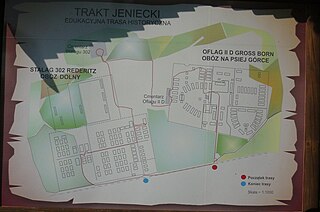
Stalag II-B was a German World War II prisoner-of-war camp situated 2.4 kilometres (1.5 mi) west of the town of Hammerstein, Pomerania on the north side of the railway line. It housed Polish, French, Belgian, Serbian, Dutch, Soviet, Italian and American prisoners of war.

In Germany, stalag was a term used for prisoner-of-war camps. Stalag is a contraction of "Stammlager", itself short for Kriegsgefangenen-Mannschaftsstammlager, a literal translation of which is "War-prisoner" "enlisted" "main camp". Therefore, technically "stalag" simply means "main camp".

Oflag II-D Gross Born (Grossborn-Westfalenhof) was a World War II German prisoner-of-war camp located at Gross Born, Pomerania, near Westfalenhof (Kłomino). It housed Polish and French officers.

Stalag XI-B and Stalag XI-D / 357 were two German World War II prisoner-of-war camps (Stammlager) located just to the east of the town of Fallingbostel in Lower Saxony, in north-western Germany. The camps housed Polish, French, Belgian, Soviet, Italian, British, Yugoslav, American, Canadian, New Zealander and other Allied POWs.

Oflag VI-B was a World War II German prisoner-of-war camp for officers (Offizerlager), 1 km (0.6 mi) southwest of the village of Dössel in Germany.
Oflag IX-C was a German prisoner-of-war camp for officers (Offizierlager) during World War II, located just to the south of the village of Molsdorf, near Erfurt in Thuringia.

Stalag VII-A was the largest prisoner-of-war camp in Nazi Germany during World War II, located just north of the town of Moosburg in southern Bavaria. The camp covered an area of 35 hectares. It served also as a transit camp through which prisoners, including officers, were processed on their way to other camps. At some time during the war, prisoners from every nation fighting against Germany passed through it. At the time of its liberation on 29 April 1945, there were 76,248 prisoners in the main camp and 40,000 or more in Arbeitskommando working in factories, repairing railroads or on farms.

Camp Fünfeichen was a World War II German prisoner-of-war camp located in Fünfeichen, a former estate within the city limits of Neubrandenburg, Mecklenburg, northern Germany. Built as Stalag II-A Neubrandenburg in 1939, it was extended by the officer camp Oflag II-E in 1940. After the Soviet takeover in 1945 until 1949 it was used as special camp, NKVD-camp Nr. 9 of the Soviet secret service (NKVD). Today, the site of the camp is a memorial.

Oflag II-C Woldenburg was a German World War II prisoner-of-war camp located about 1 kilometre (0.62 mi) from the town of Woldenberg, Brandenburg. The camp housed Polish officers and orderlies and had an area of 25 hectares with 25 brick huts for prisoners and another six for kitchens, class-rooms, theater, and administration. Now it houses a museum.

Stalag V-A was a German World War II prisoner-of-war camp (Stammlager) located on the southern outskirts of Ludwigsburg, Germany. It housed Allied POWs of various nationalities, including Poles, Belgians, Dutchmen, Frenchmen, Britons, Soviets, Italians and Americans.

Stalag XVIII-A was a World War II German Army (Wehrmacht) prisoner-of-war camp located to the south of the town of Wolfsberg, in the southern Austrian state of Carinthia, then a part of Nazi Germany. A sub-camp Stalag XVIII-A/Z was later opened in Spittal an der Drau about 100 km (62 mi) to the west.
Stalag XIII-D Nürnberg Langwasser was a German Army World War II prisoner-of-war camp built on what had been the Nazi party rally grounds in Nuremberg, northern Bavaria.

Szubin is a town in Nakło County, Kuyavian-Pomeranian Voivodeship, Poland, located southwest of Bydgoszcz. It has a population of around 9,300. It is located in the ethnocultural region of Pałuki.
Oflag XVII-A was a German Army World War II prisoner-of-war camp for officers (Offizierlager) located between the villages of Edelbach and Döllersheim in the district of Zwettl in the Waldviertel region of north-eastern Austria.

Oflag 64 was a World War II German prisoner-of-war camp for officers located at Szubin a few miles south of Bydgoszcz, in Pomorze, Poland, which at that time was occupied by Nazi Germany. It was probably the only German POW camp set up exclusively for U.S. Army ground component officers. At most other camps there were several nationalities, although they were usually separated into national compounds.

Oflag XXI-C was a German Army World War II prisoner-of-war camp for officers (Offizierlager) located in Ostrzeszów in German-occupied Poland. It held mostly Norwegian officers arrested in 1942 and 1943, but also Dutch, Italian, Serbian and Soviet POWs. Originally most Norwegian soldiers and officers had been released after the end of the Norwegian campaign, but as resistance activities increased, the officers were rearrested and sent to POW camps.
Stalag I-F was a German World War II prisoner-of-war camp located just north of the city of Suwałki in German-occupied Poland.
Oflag II-A was a German World War II prisoner-of-war camp located in the town of Prenzlau, Brandenburg, 93 kilometres (58 mi) north of Berlin. It housed mainly Polish and Belgian officers.

Stalag 383 was a German World War II Prisoner of War camp located in Hohenfels, Bavaria.

Nazi Germany operated around 1,000 prisoner-of-war camps during World War II (1939-1945).















